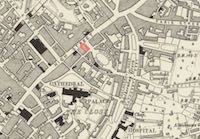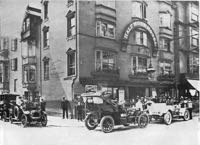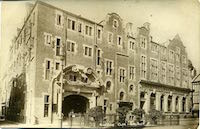
Half Moon Hotel, 22 High Street
Page updated 24th July 2015
Known as the Half Moon Inn, this was originally a coaching inn, dating from around about 1680-90. The inn was given the distinction of 'hotel' sometime after 1770, as this was the date of the country's first hotel, the Royal Clarence, in Cathedral Yard. The Half Moon had some splendid decorative plaster ceilings, which may have been installed by Thomas Lane, who had put in the ceilings in the New Inn, next door in 1689.
John Land
A sale advert in Trewman's Exeter Flying Post for December 1771 said that Mr John Land had newly occupied the Half Moon and installed "new built stables & coach houses" which comprised of 18 stalls, coach houses for 8/10 carriages and 2 hay lofts.
The next April, the sale was complete and an advert reported that John Hemmings from Bath had taken on the business, with improvements:
"He also proposes to open a genteel COFFEE-ROOM & hopes if care, attention, and an Endeavour to please can merit the Approbation of the Public, he shall be intitled (sic) to their favours."
Hemmings encountered problems at his inn when in 1774, a fire was reported. It was alleged that one of the ostlers had carelessly left a candle over some straw. The fire "was happily extinguished without doing any considerable damage". In the same issue a sale of "Mens, boys & girls stockings" was reported to be held in the hotel.
The same year as the fire, an advert was placed in the Flying Post advertising the various coaching services from the Half Moon. It is worth reading as it describes the terms and conditions for travel–compares favourably with Ryan Air.
HALF MOON IN, EXETER
LONDON AND EXETER POST COACHES! ON STEEL SPRINGS !
Set out from the said Half Moon every morning, at four o'clock (Sundays excepted], and arrive in the afternoon of the next day at the Bell Inn, Friday-street, London; returns the same time from London. Carries passengers at forty Shillings each.
Also a Plymouth Diligence from the above Inn every morning at five o'clock, to the Golden Lion, Old Town, Plymouth; and returns same time to Exon. Carries passengers at fourteen shillings each.
The above coaches meet the Gosport Coach, &c., at Salisbury, and the Diligence meets the Bath and Bristol Coaches at Exeter; each inside passenger allowed sixteen pound of luggage, all above to pay twopence per pound, to London, and one penny from Exeter to Plymouth.
All parcels, boxes, &c., will be delivered the same afternoon they arrive. No parcel, box, &o., will be paid for it lost, unless entered by the book-keeper or landlord where such things are taken in; nor will any be paid for above five pounds, unless the value is written thereon.
They call at the White Bear and the New White Horse Cellar, Piccadilly, going in and out of London.
Performed by Lily Crawley, and Parker.
A Coaching Inn
In 1844, the year of the coming of the railway from London and Bristol, the Half Moon was, along with the New London Inn and the Old London Inn, the departure point for the London stage coach, that left daily. It travelled via Honiton, Chard, Yeovil, Salisbury and Andover. The daily Nautilus coaching service to Torquay, via Dawlish and Teignmouth, leaving at 5pm, after the arrival of the London Telegraph. James Cossins remembered the arrival and departure of the coaches from the Half Moon during the first decades of the nineteenth-century:
"... the Half Moon Hotel... was kept by Mrs. Medland, afterwards by Mr. Stephens; when several coaches started for and arrived from various parts, the guards enlivening the inhabitants with tunes from their bugles. One was named "Jack Goodwin," who was considered a master of this instrument, which now is quite out of date."
Some local stage coaches survived for a few extra years after the coming of the railway, as they were often timed to coincide with the arrival and departures of trains. An advert from the Torquay and Tor Directory, April 1846.
"REIN-DEER (Fast Day Coach,) at ¼ before 8 o'clock A. M. through Teignmouth, Dawlish, Starcross, &c., to the Half-Moon Hotel, Exeter, arriving in time for the Quick Train, so as to allow passengers leaving this place in the morning, to arrive the same Day at Bath, Bristol, Cheltenham, Gloucester, Birmingham, and London."
When the parishioners beat the bounds of St Stephen's, once a year, thirty or forty would dine afterwards in the Half Moon. The hotel was also popular with local merchants who would meet in the early part of the 19th century to talk business and politics, and enjoy a glass of hot grog and a clay pipe of Dutch cut tobacco. The hotel, like others in the city was used for auctions, especially of property and estates, and the installation of a billiard table in 1871 would have encouraged a broad patronage of the hotel facilities.
Gilbert and Sullivan
On the 7 August 1882, Arthur Sullivan, of the operatic fame, stayed at the Half Moon when he was travelling back to London from Pencarrow. His partner, Gilbert met him after he had been yachting in Exmouth, to discuss the Finale of Act One of Iolanthe. The city council remembered this meeting in the naming of Savoy Hill, Chancellor's Way, Iolanthe Drive and Celia Crescent in Beacon Heath.
Entries in some 19th-century trade directories and the Flying Post, for the Half Moon:
1771 - Half Moon,
John Land, he went on to open the New London Inn Flying Post
1772 - Half Moon, John Hemmings - Flying Post
1833 - Half Moon, Wm. Stephens - Flying Post
1844 - Half Moon, Ann Stephens - Piggot's
1853 - Half Moon, Wm. Rowley - Flying Post
1868 - Half Moon, Robert
Pople - who went on to run the New London Inn
1871 - Gardner, T., half moon hotel, high-st - Pocket Journal
1878 - Half Moon, Thomas Gardner - White's
1897 - Half Moon family & commercial & posting house (John
Headon Stanbury, propr.), High street, Exeter - Kelly's
1901 - Ethel Rose Finch 30, listed as head Edmund 7 plus 18 staff -
census return
It is worth listing the staff in 1901 to see the variety of work available in the hotel trade – Porter maid 2, nurse 1, Staff maid 1, Chamber maid 3, House maid 2, Kitchen maid 1, Book keeper 1, Bar staff 2, Waiters 2, Night porter 1, and others 2.
Closed and demolished
The freehold of the hotel and adjoining premises were owned by the Kingdon family. In June 1912, it was announced that they had sold the Half Moon to Lloyds Bank, who were to demolish the building and erect a single storey bank on the High Street. At the same time, the rear of the building on Catherine Street had been obtained by Dellers of Paignton, who were to construct a café on the ground floor and a grill room and ballroom on the first floor that would extend over the new bank.
The hotel closed for the last time on Wednesday the 3 July 1912 at 5pm. Demolition by Westcott, Austin and White commenced on Monday 22 July. The famous plaster ceiling in the snooker room was donated to the Royal Albert Museum by the directors of Lloyds Bank in October 1912. The bank was completed in 1913, but it was not until 1916 that Deller's Cafe was finished.
Source - Two Thousand Years in Exeter by W G Hoskins, British Genealogy website (newspapers section), Reminiscences of Exeter by James Cossins and trade directories.
│ Top of Page │



